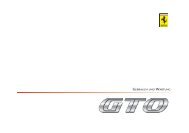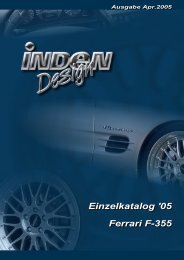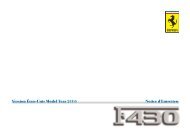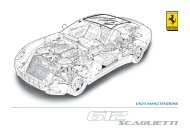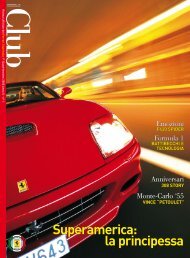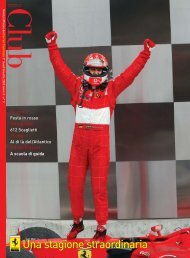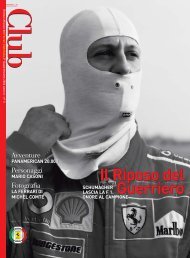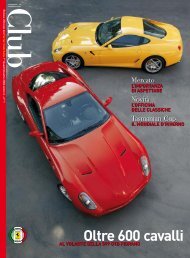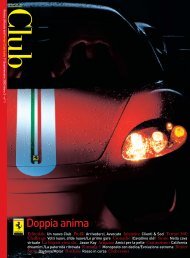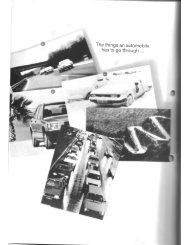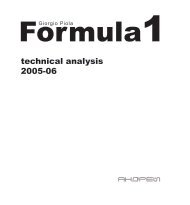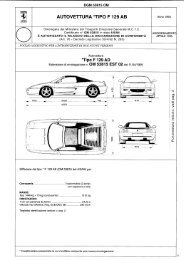360 Modena gear box manual - All Ferraris
360 Modena gear box manual - All Ferraris
360 Modena gear box manual - All Ferraris
Create successful ePaper yourself
Turn your PDF publications into a flip-book with our unique Google optimized e-Paper software.
speed depending on how the accelerator pedal is controlled: the car accelerates. As we can see,<br />
the way in which we close the clutch is strictly linked to the engine rpm and to the command the<br />
driver sends by means of the accelerator pedal.<br />
The system is designed to modify pick-up conditions, taking into account the temperature of the<br />
engine coolant: with very low temperatures, pick-up takes place with a faster engine rpm.<br />
By attempting pick-up manoeuvres repeatedly or for too long (ex.: on an uphill road, the car at a<br />
stand point, the accelerator pedal pressed), the clutch may overheat dangerously.<br />
However, thanks to a mathematical model and without the use of sensors, the TCU can detect the<br />
increase of temperature. Once reached the danger threshold, a buzzer is activated to warn the<br />
driver that the clutch might be damaged.<br />
The driver must then interrupt as soon as possible the pick-up manoeuvre, operating on the<br />
accelerator. The buzzer will start sounding every time the pick-up us attempted until the clutch will<br />
have reached normal working temperatures.<br />
IMPORTANT<br />
Reduce pick-up times whenever the buzzer starts: press harder on the accelerator pedal to prevent<br />
clutch sliding.<br />
To understand how the TCU controls <strong>gear</strong> shifting, consider the 3 subsequent operations carried<br />
out by the driver (just as with traditional mechanical transmission):<br />
• Torque reduction: at this stage, a synchronised control of engine torque reduction, clutch<br />
opening and <strong>gear</strong> release takes place.<br />
• No torque: the <strong>gear</strong> is by now completely released and the next <strong>gear</strong> is selected and engaged.<br />
• Torque return: this is when the synchronised control of clutch closing and engine torque request<br />
takes place.<br />
The various clutch control strategies are peculiar to each step:<br />
• during drive reduction, the clutch is opened according to the torque reduction controlled by the<br />
engine;<br />
• when there is no drive, the clutch is kept open;<br />
• during torque return, the clutch closing depends on the engine shaft's and the primary <strong>gear</strong><strong>box</strong><br />
shaft speeds.<br />
Clutch control during <strong>gear</strong> shifting takes into account the throttle angle (accelerator position) and the<br />
engine revolution ratio: with the pedal pressed right down and high engine revolutions, the clutch<br />
control will be set to sport mode.<br />
Gear<strong>box</strong> Control<br />
The <strong>gear</strong><strong>box</strong> control is carried out by an engagement and selection actuator controlled by the TCU<br />
through the respective solenoid valves: the pressure proportional valves control the engagement<br />
actuator, whereas the proportional solenoid valves control the selection actuator.<br />
The <strong>gear</strong> shifting actuator is controlled in accordance with the driver's requests, transmitted through



